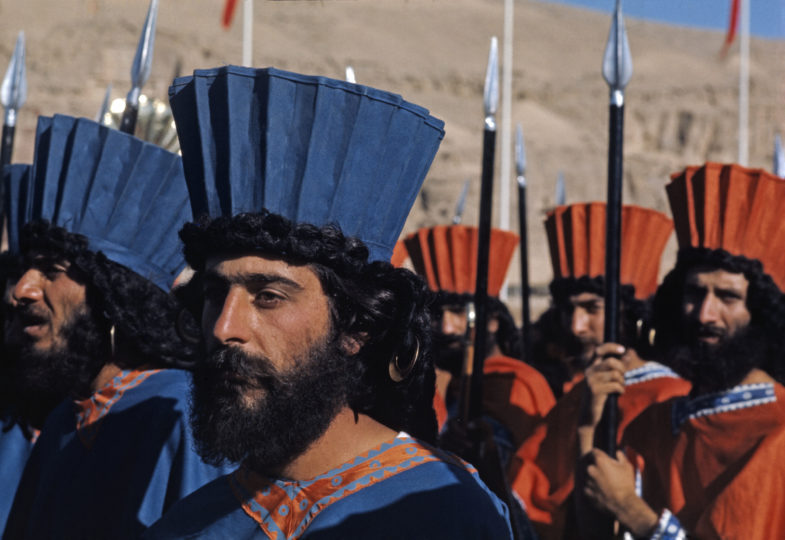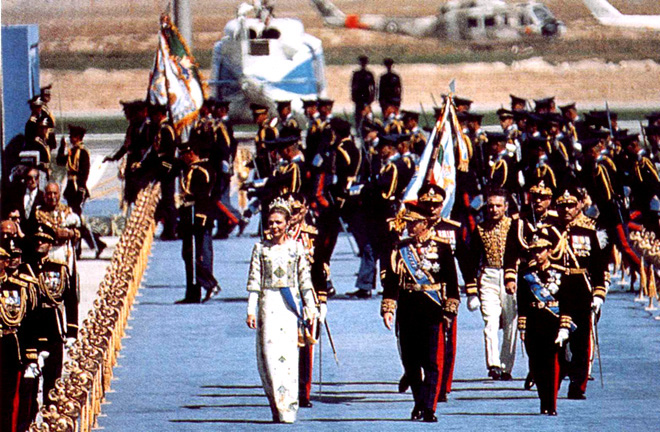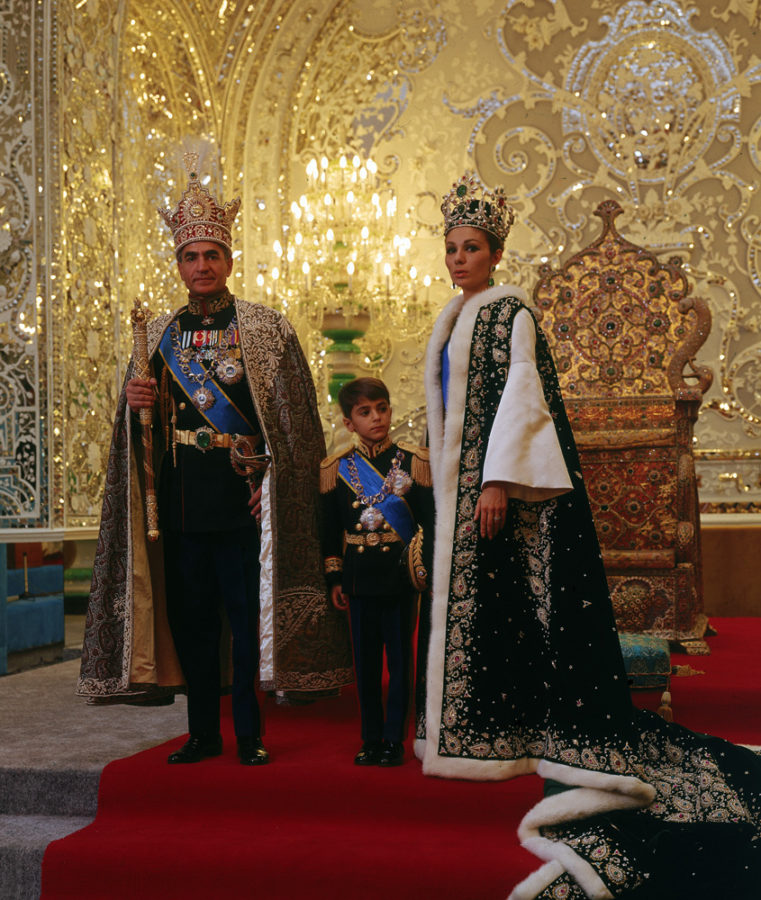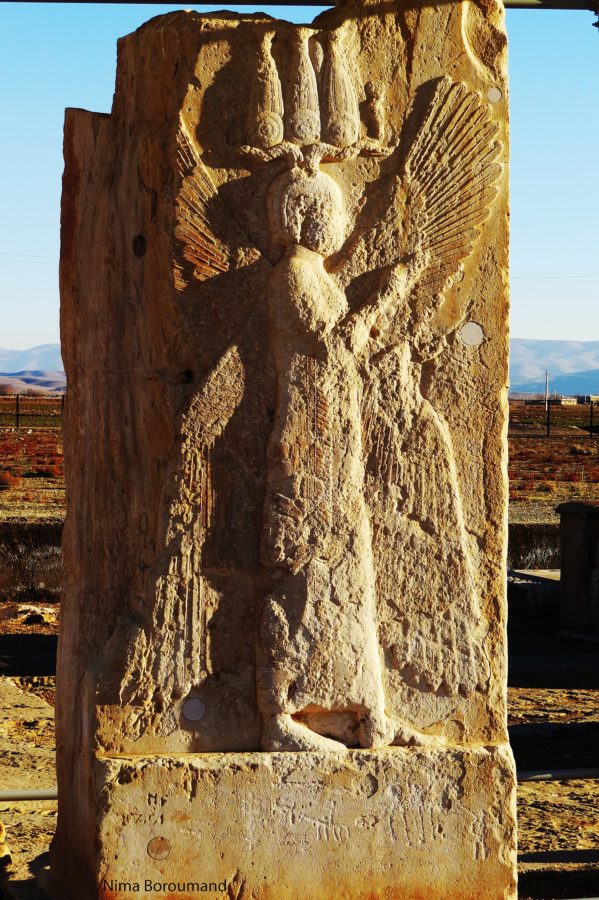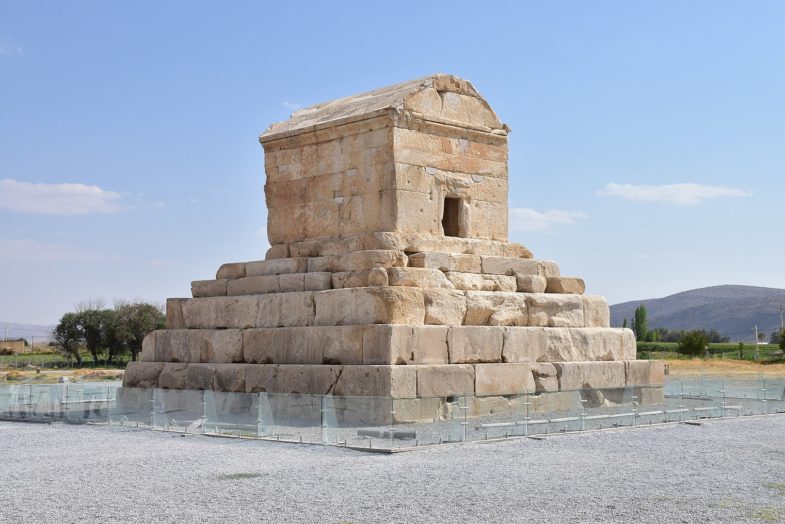
[00:00:00] Martien Halvorson-Taylor I'm Martine Halvorson-Taylor.
[00:00:02] Kurtis Schaeffer And I'm Kurtis Schaefer, and this is Sacred & Profane, a show about religion in unexpected places. And today we are talking about the age old, but still surprising ways in which religion shapes politics and politics shapes religion.
[00:00:22] Martien Halvorson-Taylor We found some fascinating appearances of an ancient king in modern political life.
[00:00:28] Martien Halvorson-Taylor We're talking about King Cyrus. You may remember that last year we didn't episode on Cyrus and his edict. The Cyrus Cylinder and how it echoes our own debates about immigration and national identity.
[00:00:44] Kurtis Schaeffer And we absolutely recommend you go back and listen to that episode. By the way. But even if you haven't listened, you may be familiar with Cyrus. He founded one of Asia's first great empires after conquering much of the Middle East in the 6th century B.C. And he's enjoyed a long and rich afterlife in our cultural imagination, partly because of the role he plays in one of the most famous stories in the Hebrew Bible.
[00:01:12] Martien Halvorson-Taylor Cyrus, after conquering the city of Babylon, issued an edict allowing a number of exiles in Babylon to return to their homelands in the Bible. He's described as setting the Jews exiled to Babylon free to return to their homeland, Jerusalem.
[00:01:34] Reader Thus, says the Lord to his anointed to Cyrus, whose right hand I have grasped to subdue nations before him and strip kings of their robes. I made the earth and created humankind upon it.
[00:01:49] Reader It was my hands that stretched out the heavens and I commanded all their host.
[00:01:55] Reader I have aroused Cyrus in righteousness, and I will make all his roads straight. He shall build my city and set my exiles free.
[00:02:10] Kurtis Schaeffer And so maybe it shouldn't be a surprise that Cyrus wasn't just a power player in the ancient world.
[00:02:17] Kurtis Schaeffer He's become a powerful symbol for political leaders in the modern world for a whole host of reasons. George Washington was called an "American Cyrus" by his supporters, both for his military victories and his outreach to American Jews. Not to be outdone, Napoleon proclaimed himself a modern siris after invading the Middle East and promising that Jews would be free to return to the Holy Land.
[00:02:44] Martien Halvorson-Taylor Today on the show, we'll look at two leaders who have become closely associated with Cyrus for very different reasons: president Donald Trump,
[00:02:52] Newsclip America's going to have a challenge either way with Trump. I believe we have a Cyrus to navigate through the storm.
[00:03:03] Martien Halvorson-Taylor And the last shah of Iran,
[00:03:06] Newsclip Cyrus, the father of Iran, which the Shah raised today.
[00:03:15] Menahem Merhavy You know, there's a lot of empty room there, a lot of space for imagination and for filling in one's own world view.
[00:03:24] Menahem Merhavy And that actually makes him, you know, the great candidate for building legitimacy around.
[00:03:30] Martien Halvorson-Taylor This is historian Menahem Merhavy. He explores, among other things, how Cyrus is remembered in modern Iran. And that's where we'll start.
[00:03:42] Martien Halvorson-Taylor Menachem says It's hard to find a clearer example of Cyrus being used as a powerful political symbol than 20th century Iran, specifically during the rule of Mohammad Pallavi, the last Shah.
[00:03:59] Menahem Merhavy He more than hinted that he was a modern Cyrus.
[00:04:07] Kurtis Schaeffer The comparison to Cyrus was part of the Shah's ongoing campaign to present himself as a legitimate ruler both inside and outside of Iran. His rule had been shaky for most of his reign. Then in 1952, Iran's popular prime minister, Mohammad Mossadeq, effectively seized control of the government. The Shah returned to power only after a coup backed by the US and UK.
[00:04:36] Menahem Merhavy For me, that I mean, the way I see it when the Shah returns, he realizes you know much more than sitting on the throne, he needs to actually legitamate his is rule all the more so since he returned with massive assistance from the West. And then he needed to, you know, to stand out as an authentic Iranian king.
[00:04:57] Martien Halvorson-Taylor Positioning himself as a modern day Cyrus helped the Shah lay claim to thousands of years of Iranian history and culture. He could paint himself as a cosmopolitan, tolerant and liberal ruler, respected his subjects. And at the same time, he could also use Cyrus to lay claim to the most important political traditions of the West.
[00:05:20] Mohammed Palavi Mesdames et messeiurs, il est extrement agreable de vous souhaite la bienvenue dans notre capital.
[00:05:28] Kurtis Schaeffer That's the voice of the shah speaking at the United Nations' very first conference on human rights. It took place in Tehran in 1968.
[00:05:39] Mohammed Palavi C'est une coincidence remarquable....
[00:05:41] Transaltor It's a remarkable coincidence because we hardly need to be reminded that it was near here that the ancestor of this document which recognizes human rights was proclaimed across this very land some twenty five hundred years ago by Cyrus the Great.
[00:06:08] Menahem Merhavy This is our state and this is you know, we started it before the West ever spoke about human rights and freedom of speech and so on and so forth. They definitely build on that a lot.
[00:06:20] Martien Halvorson-Taylor But that was just the beginning.
[00:06:24] Martien Halvorson-Taylor When I spoke with Menachem. He said the grandest example of how the Shah worked to portray himself as a modern Cyrus came in 1971.
[00:06:38] Martien Halvorson-Taylor 1971 was the year that the government launched an elaborate celebration to commemorate over 2000 years of Iranian monarchy that began with King Cyrus. The highlight was a party in the Iranian desert. It was meant to show the world that Iran had arrived on the world stage.
[00:07:02] Martien Halvorson-Taylor With the Shah at its head.
[00:07:08] Kurtis Schaeffer And it was absolutely decadent.
[00:07:11] Kurtis Schaeffer Over 60 heads of state were shuttled out to a specially built luxury tent city near the ruins of Cyrus's ancient capital. Soldiers dressed in ancient Persian uniforms won parade food and wine or flown in from one of the finest restaurants in Paris, including the main course, peacocks stuffed with Flogger. The festivities were broadcast across the world later, Orson Welles was hired to marry a feature film of the event.
[00:07:46] Orson Welles Cyrus, King of Kings. Champion—long before Magna Carta—of human rights and liberties. Cyrus, the founder of Persian Culture and the father of Iran, which the Shah rules today
[00:08:03] Menahem Merhavy Then the Shah addresses the tomb of Cyrus the Great as part of this big extravaganza.
[00:08:10] Martien Halvorson-Taylor The Shah began by addressing Cyrus —"Korosh" in Farsi—one king to another.
[00:08:18] Mohammed Palavi Korosh.
[00:08:21] Orson Welles O Cyrus, great King. King of Kings. Achemedian King.
[00:08:31] King of the Land of Iran by the Shah and Shah of Iran.
[00:08:36] Offer these salutations from myself and from my nation.
[00:08:42] Menahem Merhavy You know, "I King of the King of Iran. You know, I salute you. Rest in peace because we are here to keep on the good work." Or something like that.
[00:08:57] Martien Halvorson-Taylor But the event came to underscore the difference between how Iranians remembered the actual Cyrus, the benevolent ruler of a proud and diverse Iranian empire.
[00:09:08] And how many saw the Shah as the leader of an oppressive police state propped up by foreign powers, and the sheer cost of the party estimated to have run over six hundred million dollars didn't help either.
[00:09:33] Kurtis Schaeffer These costly celebrations of Cyprus became major political fodder for Ayatollah Khomeini, who had helped deposed the Shah and establish the Islamic Republic.
[00:09:44] Menahem Merhavy It kind of backfired in the sense that Iranians didn't buy it as buying legitimacy to the Pahlavi state. However, they did not throw the baby with the bath tub.
[00:09:58] Kurtis Schaeffer That is to say, while the Shah is gone, Cyrus is still a popular figure among Iranians. And especially in the Iranian diaspora. Cyrus and his edict remain a source of pride, colosely associated with human rights and religious freedom.
[00:10:15] Martien Halvorson-Taylor In other words, this comparison fails not because people didn't see good qualities in Cyrus, but because it was an image created by the Shah himself. It's a bit like giving yourself your own nickname—it won't stick if it's not something people on the ground truly believe.
[00:10:33] Kurtis Schaeffer And that's one key difference in the comparison between Cyrus and President Trump.
[00:10:40] Netanyahu I want to tell you, the Jewish people have a long so we remember the proclamation of the great things Cyrus the great version 25 when he proclaimed that Jewish exiles in Babylon could come back and rebuild our temple. And we remember how a few weeks ago, President Donald J. Brown recognized Jerusalem Jews.
[00:11:07] Martien Halvorson-Taylor That was Israeli Prime Minister Benjamin Netanyahu at a press conference in 2018.
[00:11:15] Kurtis Schaeffer Netanyahu is far from alone in making the Trump Cyrus connection.
[00:11:19] Newsclip U.S. evangelical Christians are divided about what to do with Donald Trump. The views range from standing with him, abandoning him or believing he has a biblical mandate.
[00:11:31] I walked out of that office after meeting with him and I knew God had chosen him for such a time as this guy was raising him up like Cyrus.
[00:11:42] It's not a normal election. And so we it was we almost need a different kind of candidate. Trump has the Cyrus anointing.
[00:11:55] Sarah Posner I think that in all things in evangelical Republican politics, it really is more about politics than it is about the religion.
[00:12:03] Martien Halvorson-Taylor This is reporter Sarah Posner.
[00:12:05] Sarah Posner My name is Sarah Posner. I've been covering the Christian right and Republican politics and the evangelical quest for the perfect presidential candidate, which they ultimately appear to find in, surprisingly, Donald Trump.
[00:12:21] Martien Halvorson-Taylor So Trump's support among white evangelicals seems like such established fact. Now, let's go back to when he first seemed to become their preferred candidate, which is when you begin to see these comparisons to Cyrus start to pop up. Why did Cyrus become this powerful frame for Trump's candidacy?
[00:12:44] Sarah Posner Well, I think first, a little context is in order to understand what.
[00:12:51] Politicized evangelicals have been traditionally looking for in a presidential candidate since the Reagan era.
[00:13:04] Since that time, they have basically created a litmus test for Republican presidential candidates that they applied in primaries.
[00:13:13] Newsclip Governor Bush, philosopher, thinker and why Christ? Because he changed my heart. I think the viewer would like to know more on how things change. Well, it's I don't know. It's going to be hard to explain when you accept Christ as a savior. It changes your heart, changes your life. And that's what.
[00:13:34] Sarah Posner This person has to have a relatable salvation story. They have to be a professing Christian. They have to be a good family man.
[00:13:43] And by that, I literally mean man.
[00:13:46] And they had to check off all of these boxes, including not just being a Christian, but also promising to govern from a Christian worldview or from a biblical worldview. And Trump, he was so obviously on April to even provide the most cursory basic answers to those questions that evangelicals wanted answered.
[00:14:12] Donald Trump So I hear this is a major theme right here. But two Corinthians, right? Two Corinthians 3 17.
[00:14:19] That's the whole ballgame. Is that the one? Is that the one you like? I think that's the one you like because I loved it. And it's so representative of what's taken place.
[00:14:37] Sarah Posner So they had a bit of a problem in Trump in 2016 because obviously he was not checking off those boxes yet. The evangelical base was falling head over heels for him. So what you saw, particularly in the charismatic and Pentecostal subculture of American evangelicalism, was a number of different people claiming to have insight into biblical prophecy.
[00:15:11] Newsclip Trump. Why did you pick him?
[00:15:14] I began to see what a lot of Christians saw was that God was raising up this man who we didn't even necessarily like.
[00:15:23] Sarah Posner And, well, perhaps Trump wasn't a Christian, but perhaps he was instead a leader that God sent to America at this time to save America. Much like Cyrus enabled the Jews to rebuild Jerusalem.
[00:15:39] And so I then it kind of just continue to catch fire such that the Cyrus comparison just became very commonplace in evangelical discussions about Trump and has even been used by Israeli Prime Minister Benjamin Netanyahu to say that Trump is like Cyrus to the Israeli people.
[00:16:04] Martien Halvorson-Taylor So let's sort of talk about the substance of the comparison in likening Trump to Cyrus. They're acknowledging that he is not of the tribe. Right. So he's a he's a gentile king. Right. And the end, they're figuring him as a divine instrument. Yes. It's a way of accommodating for his not looking like a Christian leader. Exactly. And so what else does it account for in him? How else does the comparison work?
[00:16:40] Sarah Posner Well, oddly enough, the comparison works because he's the. Now, the forty fifth president and Cyrus is discussed in the forty fifth chapter of Isaiah. That is also a very common theme that you'll see played out in these evangelical circles as sort of further justification or as a way of further bolstering their claim that this is this is God's hand on Trump. Trump is a leader who's maybe not one of us, but he understands us. And God sent him at this time to save us from to save us. When they say us, they mean, you know, they're white Christian view of America to save us from these other forces, whether it's, you know, secularism, feminism, socialism. Trump is saving us from all of that.
[00:17:34] Kurtis Schaeffer Is there a sense when you say evangelicals feel that he's on their side? Is there a sense that the evangelical community is beleaguered or under threat?
[00:17:45] Sarah Posner Yes. I mean, that is precisely why they see him as this savior figure, because to them, you know, Roe versus Wade, Obergefell, this Supreme Court decision that legalized same sex marriage. All of these things are taken by evangelicals as being a threat to Christianity and therefore, in their view, to their religious freedom.
[00:18:10] Martien Halvorson-Taylor How much has has Trump actively cultivated people aligning him with with Cyrus?
[00:18:18] Sarah Posner That's a good question. He certainly hasn't done anything to tamp it down, and none of his surrogates have done anything to tamp down that talk. I think that there have probably been situations where it has been said in his presence. But I also haven't seen him like pound his chest to say he's like King Cyrus, although I think, you know, anything's possible.
[00:18:40] Martien Halvorson-Taylor As you know, there been a number of people who have touted the comparison to Cyrus, and they can come from all sorts of different traditions. So David Koresh was one. And of course, the Shah was another.
[00:18:52] You know, in all those cases, it was a person, you know, choosing to contextualize their mission in the history of of a great figure. This feels different.
[00:19:06] Sarah Posner Yes. It did not come originally from Trump. And I think it's important to understand that it comes from this subculture of evangelicalism, where it's extremely common place for a self-anointed prophet to say that he or she has, you know, prophesy that some event is going to come to pass, such as Trump will win the presidency, for example. And for this demographic, somebody making that kind of comparison about a public figure isn't so unusual. You know, there's a lot of talk about a particular moment in history being someone's Esther moment. Again, you know, we're back in Persia.
[00:19:47] But, you know, the Esther moment being you know, it's your moment to save your people from a genocide or it's your moment to save America from liberalism.
[00:19:57] But I think that the Cyrus comparison has a very different feel to it. The Esther comparison is about each individual being able to play a role.
[00:20:12] Newsclip Could it be that you have come to the kingdom for such a time as this? In other words, an Esther moment. And God has ordained that at some moment in life.
[00:20:26] Sarah Posner Your research, you know that you can have your Esther moment if you get involved in politics and save America from these evils, whereas the Cyrus comparison for Trump is very much about this. Pretty much bowing down to this on this great leader.
[00:20:50] Kurtis Schaeffer Menahem and Sarah, give us two great examples of how stories from the ancient world are used in contemporary politics.
[00:21:01] Both accounts of how science was used make me wonder more broadly about the power of stories from the ancient world.
[00:21:10] Martien Halvorson-Taylor There's something there. There's something about the story of Cyrus as uncovering an ultimate truth about leadership and about destiny.
[00:21:22] There's something really kind of sweeping in what Cyrus does that makes him such a compelling model for generations afterwards.
[00:21:34] Kurtis Schaeffer So in this case of the Shah, I can get that because in part he's got great stage props.
[00:21:41] It makes for great theater, right. He can go to ruins and speak through the millennia to that leader who lived there.
[00:21:51] It's it's like something out of an opera with the Trump case. I don't get it so much. Right.
[00:22:00] Martien Halvorson-Taylor Yeah. So the Shah has has the land.
[00:22:02] He's got Cyrus, his tomb, Trump and his evangelical followers. They've got the Bible. You know, Cyrus is in some of the most beautiful passages in the book of Isaiah. He figures in a number of other important books as well. He is a major figure. I think for me, one of the things that it shows me is that we have a book in this case the Bible or we have an edict, you know, in this case the Cyrus Cylinder. And they're both open to interpretation and people can appropriate them in very highly creative ways.
[00:22:45] Kurtis Schaeffer Well, there's something powerful about being able to talk directly to the past. The Shah did it right. He was speaking, speaking to Cyrus in a leader to leader through thousands of years and in the case of evangelical communities. They have made Trump into a biblical figure. They have made Trump into a character who now has thousands of years of history behind him. And that's a powerful thing to do.
[00:23:18] Martien Halvorson-Taylor Right. And there's also something very affirming about looking toward an uncertain future. With all the confidence that you know how it works out, because you know about this biblical past or this ancient.
[00:23:35] King Cyrus.
[00:23:36] Kurtis Schaeffer Yeah. Even in the midst of crisis, you know that it's going to work out because it's worked out before.
[00:23:52] Sacred and profane is produced for the religion, race and democracy at the University of Virginia. Our guests are Menahem Merhavy and Sarah Posner. Her book, "Unholy: Why Evangelicals Worship at the Altar of Trump" will be out this May. Our communications manager is Ashley Duffalo. Emily Gadek is our senior producer. Kelly Jones is the lab's editor.
[00:24:19] Music on this episode comes from Blue Dot Sessions. You can find out more about our work at religion. Lab, Dot Virginia, Dot e._d._u, or by following us on Twitter at the religion lab. And if you like the show. Head over to iTunes or the platform of your choice to rate and review us. It really makes a difference for new shows like ours.
Last season, we explored the impact of an ancient artifact with Biblical connections: the Cyrus cylinder.
The cylinder is a version of an edict that’s central to the story of Jewish exile in Babylon. When Cyrus conquered Babylon, he issued a proclamation allowing them, and all of the conquered peoples living in Babylon to return to their homelands to worship their own gods.
Cyrus’s proclamation may be ancient, but it has a lot of resonance in modern discussions of religious freedom, immigration, and national identity. Perhaps then it shouldn’t come as a surprise that Cyrus himself has become a political symbol, as well. George Washington’s supporters called him an “American Cyrus,” referring both to his military prowess and his outreach to American Jews. Not to be outdone, Napoleon claimed the title of “a modern Cyrus” for himself a few years later after occupying the Middle East. He wasn’t the only one who claimed the illustrious title for himself: it was reported that Harry Truman, after being introduced as “the man who helped create the state of Israel” retorted “Helped to create? I am Cyrus.”
In the last fifty years, two very different leaders have become closely associated with Cyrus: the last Shah of Iran, and President Donald Trump.
The Shah saw Cyrus as a chance to claim legitimacy both inside and outside of Iran. In Iran, he played on the idea that his rule was the continuation of 2,500 years of monarchy beginning with Cyrus; outside Iran, he held up the Cyrus cylinder as the ‘first declaration of human rights’ and the earliest example of a ruler granting religious freedom.
In contrast, Donald Trump hasn’t seized the mantle of Cyrus for himself. But it has become a popular way for many of his evangelical supporters to explain their support for him. In this interpretation, it doesn’t matter if he isn’t able to quote scripture, or if he lives a particularly moral life. Like Cyrus. they argue, he’s an outsider who doesn’t need to be devout. He is being used as an instrument of God.
How to cite this episode:
Halvorson-Taylor, M., Schaeffer K. (Presenters), Merhavy, M., Posner, S. (Guests), & Gadek, E. (Producer), “What’s So Great About Cyrus?” Sacred & Profane (2020, May 18).
Related Content:
I Sent the Gods Back
Season 1/Episode 5
What does King Cyrus the Great’s edict—a symbol of liberation and religious freedom—teach us today?
Additional Reading
Decadence and Downfall: The Shah of Iran’s Ultimate Party. Directed by Hassan Amini. London: Amber Entertainment, 2016.
Hamilton, Mark. W. “Who Was a Jew? Jewish Ethnicity during the Achaemenid Period.” Restoration Quarterly 37 (1995): 102-117.
Harrop, William Scott. “Cyrus and Jefferson: Did They Speak the Same Language?” Middle Eastern and South Asian Languages and Cultures 13, no. 1 (Spring 2013).
Kohl, Philip L. “Nationalism and Archaeology: On the Constructions of Nations and the Reconstructions of the Remote Past.” Annual Review of Anthropology 27 (1998): 223-46.
Kuhrt, Amélie. “Cyrus the Great of Persia: Images and Realities”. In Heinz, Marlies; Feldman, Marian H. Representations of Political Power: Case Histories from Times of Change and Dissolving Order in the Ancient Near East. Winona Lake, IN: Eisenbrauns, 2007.
Merhavy, Menahem. “Religious Appropriation of National Symbols in Iran: Searching for Cyrus the Great.” Iranian Studies 49, no. 6 (2015): 933-948.
Minazad, Orly. “What the Cyrus Cylinder at the Getty Villa Means to L.A.’s Iranian Community.” LA Weekly, October 8, 2013.
Posner, Sarah. Unholy: Why White Evangelicals Worship at the Altar of Donald Trump. Random House, May 26, 2020.
Swenson, Kristin. Bible Babel: Making Sense of the Most Talked About Book of All Time. HarperCollins, 2010.
Additional Credits
Thank you to our readers, Meghan Hartman and Peter Jacobs.
Image Citations:
(Top banner)
Barbey, Bruno. Festivities to celebrate the 2500th anniversary of the Empire and its restoration as a state. Iran, Persepolis, 1971. © Bruno Barbey/Magnum Photos.
(Slider, in order of view)
Barbey, Bruno. Festivities to celebrate the 2500th anniversary of the Empire and its restoration as a state. Iran, Persepolis, 1971. © Bruno Barbey/Magnum Photos. Image manipulated with permission of Magnum Photos.
The arrival of Shah Mohammad Reza, Shahbanu Farah and Crown Prince Reza in front of Cyrus’ tomb, October 12, 1971, Pasargad, Iran. <https://commons.wikimedia.org/wiki/File:ShahanshahiIran2500YearsPasargad1.jpg> accessed 18 May, 2020.
Shah Mohammad Reza with his consort and crown prince after the coronation, 1967, Tehran, Iran. <https://commons.wikimedia.org/wiki/File:Shah,_Reza_and_Farah.jpg> accessed 18 May, 2020.
Attanasio, Dino. Cover image: The Regained Glory, a comic book on the biography of Mohammad Reza, 1976. <https://commons.wikimedia.org/wiki/File:Azemat_e_bazyafteh_-_entesharat_e_universal_cover_book.jpg> accessed 18 May, 2020.
Boroumand, Nima. Cyrus the Great, Pasargad, Iran. 15 January, 2016. This works is licensed under Nima Boroumand / Creative Commons Attribution-NonCommercial-ShareAlike 4.0 International License. <https://commons.wikimedia.org/wiki/File:Cyrus_the_great.jpg> accessed 18 May, 2020.
Bernd81. The Tomb of Cyrus the Great, Pasargad, Iran. 15 September, 2017. This work is licensed under Creative Commons Attribution-NonCommercial-ShareAlike 4.0 International License. <https://commons.wikimedia.org/wiki/File:Pasargad_Tomb_Cyrus3.jpg> accessed 18 May, 2020.


